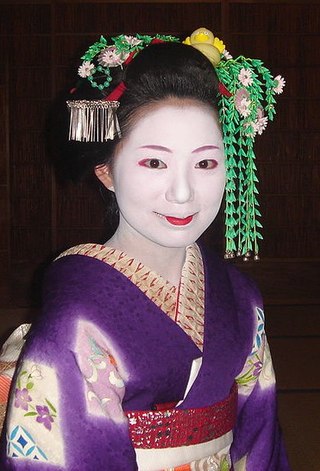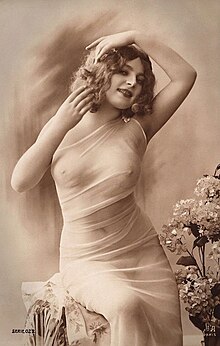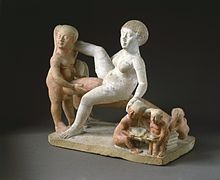
Eroticism is a quality that causes sexual feelings, as well as a philosophical contemplation concerning the aesthetics of sexual desire, sensuality, and romantic love. That quality may be found in any form of artwork, including painting, sculpture, photography, drama, film, music, or literature. It may also be found in advertising. The term may also refer to a state of sexual arousal or anticipation of such – an insistent sexual impulse, desire, or pattern of thoughts.

In Japan, pornography has unique characteristics that readily distinguish it from western pornography. Pornographic films are known as "adult videos" (AV) in Japan, so Japanese adult videos (JAV) refers to the Japanese pornographic film industry. Animated films are referred to as hentai in English, but in Japan the terms "adult anime" and "erotic animation" are used. In addition to pornographic videos and magazines featuring live actors, there are now categories of pornographic manga and anime, and pornographic computer games.

Softcore pornography or softcore porn is commercial still photography, film, or art that has a pornographic or erotic component but is less sexually graphic and intrusive than hardcore pornography, defined by a lack of visual sexual penetration. It typically contains nude or semi-nude actors involved in love scenes and is intended to be sexually arousing and aesthetically beautiful. The distinction between softcore pornography and erotic photography or art, such as Vargas girl pin-ups, is largely a matter of debate.

Erotic art is a broad field of the visual arts that includes any artistic work intended to evoke arousal. It usually depicts human nudity or sexual activity, and has included works in various visual mediums, including drawings, engravings, films, paintings, photographs, and sculptures. Some of the earliest known works of art include erotic themes, which have recurred with varying prominence in different societies throughout history. However, it has also been widely considered taboo, with either social norms or laws restricting its creation, distribution, and possession. This is particularly the case when it is deemed pornographic, immoral, or obscene.

Erotic literature comprises fictional and factual stories and accounts of eros intended to arouse similar feelings in readers. This contrasts erotica, which focuses more specifically on sexual feelings. Other common elements are satire and social criticism. Much erotic literature features erotic art, illustrating the text.

Tentacle erotica is a type of pornography most commonly found in Japan that integrates traditional pornography with elements of bestiality, fantasy, horror, and science fiction. It is found in some horror or hentai titles, with tentacled creatures having sexual intercourse, predominantly with females or, to a lesser extent, males. Tentacle erotica can be consensual but mostly contains elements of rape.

Pornographic magazines or erotic magazines, sometimes known as adult magazines or sex magazines, are magazines that contain content of an explicitly sexual nature. Publications of this kind may contain images of attractive naked subjects, as is the case in softcore pornography, and, in the usual case of hardcore pornography, depictions of masturbation, oral, manual, vaginal, or anal sex.
Erotic photography is a style of art photography of an erotic, sexually suggestive or sexually provocative nature.

Homoeroticism is sexual attraction between members of the same sex, including both male–male and female–female attraction. The concept differs from the concept of homosexuality: it refers specifically to the desire itself, which can be temporary, whereas "homosexuality" implies a more permanent state of identity or sexual orientation. It has been depicted or manifested throughout the history of the visual arts and literature and can also be found in performative forms; from theatre to the theatricality of uniformed movements. According to the Oxford English Dictionary, it is "pertaining to or characterized by a tendency for erotic emotions to be centered on a person of the same sex; or pertaining to a homo-erotic person."

Lesbian erotica deals with depictions in the visual arts of lesbianism, which is the expression of female-on-female sexuality. Lesbianism has been a theme in erotic art since at least the time of ancient Rome, and many regard depictions of lesbianism to be erotic.

Erotic horror, alternately called horror erotica or dark erotica, is a term applied to works of fiction in which sensual or sexual imagery are blended with horrific overtones or story elements for the sake of sexual titillation. Horror fiction of this type is most common in literature and film. Erotic horror films are a cornerstone of Spanish and French horror.

Pornography has been defined as sexual subject material "such as a picture, video, or text" that is intended for sexual arousal. Intended for consumption by adults, pornography depictions have evolved from cave paintings, some forty millennia ago, to virtual reality presentations. A general distinction of adult content is made classifying it as pornography or erotica.

The history of erotic depictions includes paintings, sculpture, photographs, dramatic arts, music and writings that show scenes of a sexual nature throughout time. They have been created by nearly every civilization, ancient and modern. Early cultures often associated the sexual act with supernatural forces and thus their religion is intertwined with such depictions. In Asian countries such as India, Nepal, Sri Lanka, Japan and China, representations of sex and erotic art have specific spiritual meanings within native religions. The ancient Greeks and Romans produced much art and decoration of an erotic nature, much of it integrated with their religious beliefs and cultural practices.
Women's erotica is any erotic material that caters specifically to women target-demographic of various sexual preferences. When erotica is specifically directed at lesbians, it is referred to as lesbian erotica. Women's erotica is available from a variety of media including video games, websites, books, comics, short stories, films, photography, magazines, audio, anime and manga. The content may cover many aspects of sexuality, from relationships to fetishes; the main idea being to convey sex-positivism from a woman's perspective, or to feature female empowerment and sexual fantasies.
In the United Kingdom, pornography is regulated by a variety of laws, regulations, judicial processes, and voluntary schemes. Pornographic material generally has to be assessed by regulators or courts to determine its legality. British censorship laws with regard to pornography have often been some of the most restrictive in Western Europe.
Feminist views on pornography range from total condemnation of the medium as an inherent form of violence against women to an embracing of some forms as a medium of feminist expression. This debate reflects larger concerns surrounding feminist views on sexuality, and is closely related to those on prostitution, BDSM, and other issues. Pornography has been one of the most divisive issues in feminism, particularly in Anglophone (English-speaking) countries. This division was exemplified in the feminist sex wars of the 1980s, which pitted anti-pornography activists against pro-pornography ones.
In the Philippines, pornography is not specifically defined in Philippine law, but the Revised Penal Code of the Philippines considers certain acts to be obscene or indecent and these are prohibited as immoral doctrines, obscene publications, indecent shows, or other similar material or portrayals that advocate human immorality, obscenity, and indecency. Philippine legislation penalizes participation in these unlawful activities, and Republic Act No. 7610 extends punishment to those involved in child abuse, child exploitation, child prostitution and discrimination of children.

Sexuality in Japan developed separately from that of mainland Asia, as Japan did not adopt the Confucian view of marriage, in which chastity is highly valued. Monogamy in marriage is often thought to be less important in Japan, and sometimes married men may seek pleasure from courtesans. Prostitution in Japan has a long history, and became especially popular during the Japanese economic miracle, as evening entertainments were tax-deductible. Decreased sex drive in the 21st century has been blamed for the low Japanese birth rate and declining growth of the Japanese population.
Feminist pornography is a genre of film developed by or for those within the sex-positive feminist movement. It was created for the purpose of promoting gender equality by portraying more bodily movements and sexual fantasies of women and members of the LGBT community.

Victorian erotica is a genre of sexual art and literature which emerged in the Victorian era of 19th-century Britain. Victorian erotica emerged as a product of a Victorian sexual culture. The Victorian era was characterized by paradox of rigid morality and anti-sensualism, but also by an obsession with sex. Sex was a main social topic, with progressive and enlightened thought pushing for sexual restriction and repression. Overpopulation was a societal concern for the Victorians, thought to be the cause of famine, disease, and war. To curb the threats of overpopulation and to solve other social issues that were arising at the time, sex was socially regulated and controlled. New sexual categories emerged as a response, defining normal and abnormal sex. Heterosexual sex between married couples became the only form of sex socially and morally permissible. Sexual pleasure and desire beyond heterosexual marriage was labelled as deviant, considered to be sinful and sinister. Such deviant forms included masturbation, homosexuality, prostitution and pornography. Procreation was the primary goal of sex, removing it from the public, and placing it in the domestic. Yet, Victorian anti-sexual attitudes were contradictory of genuine Victorian life, with sex underlying much of the cultural practice. Sex was simultaneously repressed and proliferated. Sex was featured in medical manuals such as The Sexual Impulse by Havelock Ellis and Functions and Disorders of Reproductive Organs by William Acton, and in cultural magazines like The Penny Magazine and The Rambler. Sex was popular in entertainment, with much of Victorian theatre, art and literature including and expressing sexual and sensual themes.













